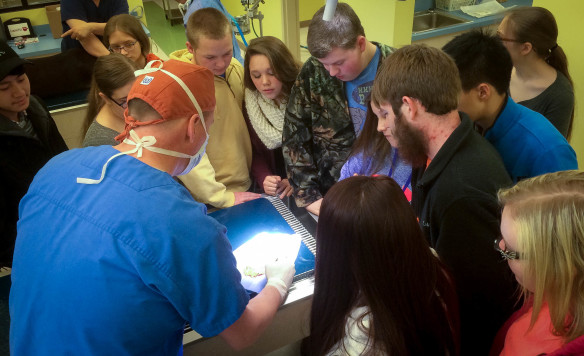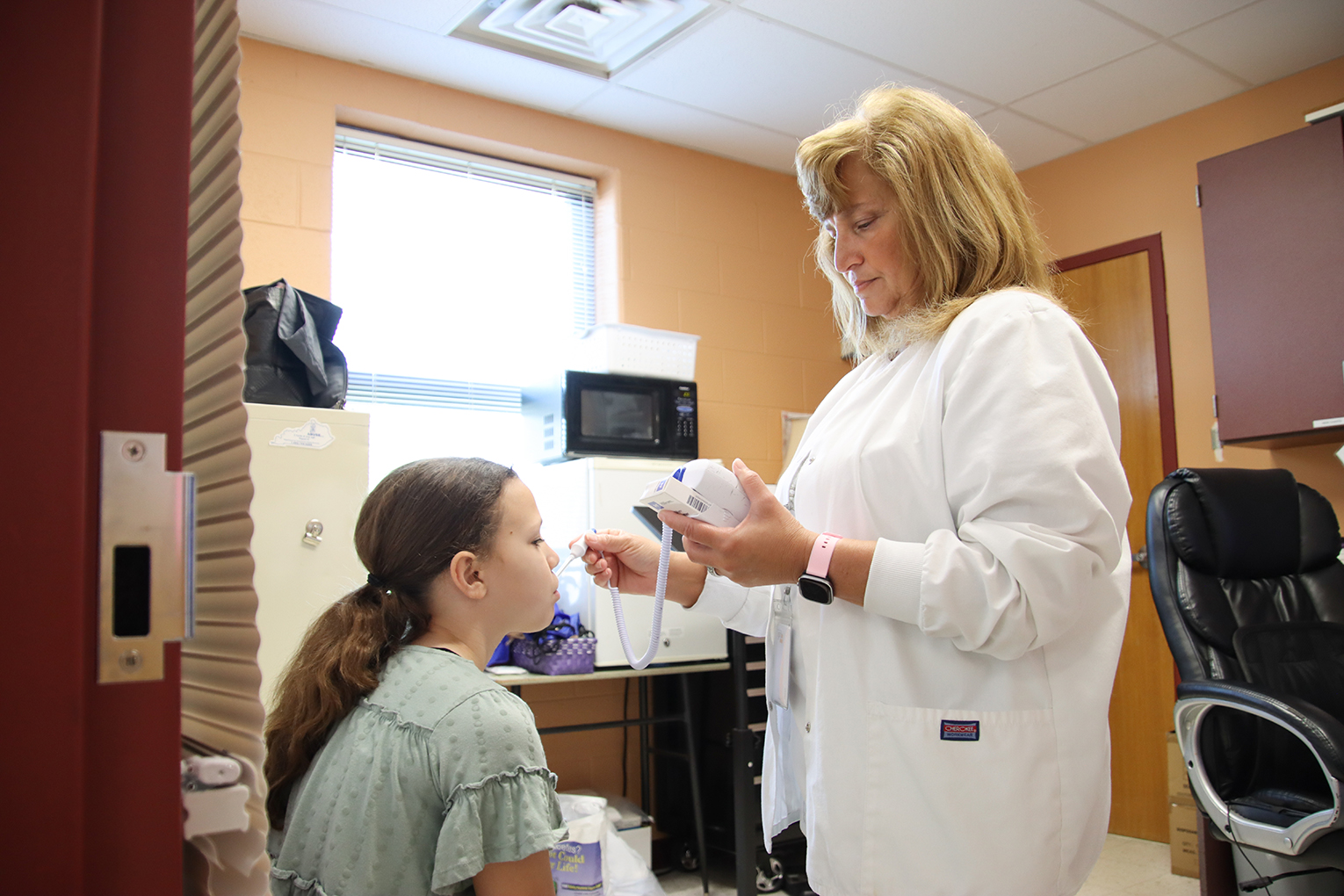
Students in Franklin-Simpson High School’s agriculture program scored higher than both the school and state average on last year’s ACT. These veterinary science students observe a surgery at a local animal hospital.
Photo provided by Simpson County schools
By Brenna R. Kelly
Brenna.kelly@education.ky.gov
Taking a career and technical education class at Franklin-Simpson High School used to mean walking outside to a separate building.
Then about six years ago the school built a gymnasium between the high school building and the career and technical center to create one big building.
“I have only been here post-gym, but everyone says there has been a huge change in culture,” said Sam Evans, one of the school’s agricultural teachers. “Prior to being connected, it was a very us and them mentality.”
Today, the old stereotypes of career and technical education (CTE) classes being for students who can’t cut it academically or who don’t plan to go to college are gone.
“I think connecting the building brought about a change in expectations and perceptions,” Evans said.
Students now understand that CTE classes can lead to gainful employment after high school, give them a jump start on college credit and teach them real-world skills not covered in academic classes.
More than a quarter of Franklin-Simpson’s 890 students are enrolled in one of the agriculture program’s classes, said Felicia Dalton, also an agriculture teacher. It makes sense in Simpson County, which lies along the Tennessee border, where about 80 percent of land is in some type of agriculture production, she said.
And the program has become one of the top academic achieving agricultural programs in the state.
Last school year, the school ranked 5th in ACT scores out of 143 agriculture programs in the state, according to the Kentucky Department of Education (KDE). The students had an average composite score of 20.7, higher than the school’s average composite score of 19.3 and the state’s composite score of 19.4.
“Their students have really performed well not just in getting the occupational or the technical content in agricultural education, but also from an academic standpoint as proven by their ACT scores,” said Brandon Davis, state supervisor of Agricultural Education for KDE.
Successfully combining classroom instruction, supervised work-based learning and leadership development through Future Farmers of America is what educators consider the sweet spot of agriculture education, Davis said.
“They are one of the programs that have not only worked to build their classroom instruction to a high level, but also to engage students in work-based learning and in leadership development through FFA,” Davis said.

Students in Franklin-Simpson High School’s agriculture power pathway recently built a shed for a Habitat for Humanity home during their Agriculture’s Structures and Design class.
Photo provided by Simpson County schools
Evans and Dalton said they can’t take credit for the program’s achievements.
“I think a lot of the credit goes to the core subject teachers,” Dalton said. “But on our end we do try to do bell-ringers (end of class activities) and those kinds of things that will help them prepare.”
“A great deal of our success is because we are at a quality school,” Evans said. “We’re in a very, very good setting with very good leadership as far as administration.”
In the 2014-15 school year, the school ranked in the 97th percentile in the state’s accountability system and was labeled a distinguished school. It’s a label far different from the one Franklin-Simpson received in 2011-12, when it was designated as Priority school. At that time, the school ranked in the 45th percentile in the accountability system and was one of the lowest-performing schools in the state. But one year later, the school ranked in the 97th percentile. Today, Franklin-Simpson’s turnaround is held up as an example for other struggling schools. As a KDE designated Hub school, Franklin-Simpson shows off its best practices and provides support to schools in the area that are working to improve student achievement.
One of those practices is a graduation requirement that every student be college- or career-ready, Evans said. Franklin-Simpson was the first high school in the state to make that goal a graduation requirement. It has led to an increased focus on career and technical education pathways, Evans said.
The agriculture program offers three pathways – animal science, agriculture power and horticulture. It plans to add a fourth next year, environmental science, which will include forestry, wildlife management, aquatics and soil and plant science.
Both Evans and Dalton said they use a project-based learning approach in their classes that allows students to put into practice what they have learned in the classroom.
“The high-level critical thinking in my classes takes place probably not where you think. It takes place in the shop,” Evans said.
When students are building a project, Evans gives them a set of plans and then backs off.
“I try not to be the one with all the answers,” he said. “I make it so they are the ones that have to figure it out.”
The school opened a new state of the art greenhouse last year that allows horticulture students to get real-world experience. The students grow annuals, ferns, vegetables and fruit to sell to the public. Students learn more than just growing and fertilizing plants, however. They also learn to price items based on costs, communicate with customers and count change for sales.
The new greenhouse replaced a 34-year-old building that was crumbling, she said. It has a state of the art heating and cooling system, automated irrigation and a polycarbonate covering that will allow the students to start a hydroponic system to grow lettuce and tomatoes.
“We put in drip irrigation for hanging baskets and the students built new greenhouse tables to go inside,” Dalton said. “And a sales counter top so people can set their stuff down and check out.”
The program also has led to a 5th-place finish for the agronomy team in FFA’s national championships held in Louisville last fall and longtime agriculture teacher David Duncan being named one of FFA’s Ag Teachers Change Lives award winners for 2015.
With all of the accolades Evans said Franklin-Simpson doesn’t have a secret recipe to give out.
He believes it’s no secret at all.
“We have good students, good leadership and good teachers everywhere else in the school,” he said. “As teachers, we feel like we capitalize on our students whenever we have them in our rooms, but there’s a lot of glory that has to be shared with all the other teachers and the kids themselves.”
MORE INFO …
Samuel Evans Samuel.Evans@simpson.kyschools.us
Felicia.Dalton Felicia.Dalton@simpson.kyschools.us






Leave A Comment